|
A worthy project
by PAULINE LISTER
An exhibition of
Queen Maud's wardrobe at the V&A museum inspired
Jim and Brenda Jones to establish a new exhibition gallery
in Lincolnshire and recreate a Worth dress to display in it
|
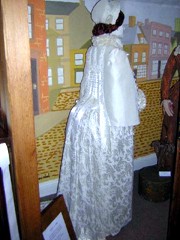 |
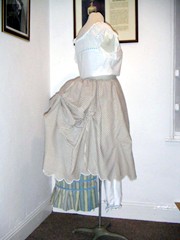 |
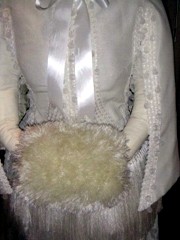 |
|
An exhibition at the V&A inspired the
creation of this replica Charles Worth dress |
Even the underclothes were replicated to
give a really authentic feel to the dress |
Collar and muff knitted by
Debbie Hallam although the originals were made from fur
|
Charles Frederick Worth
1825 -1895
In 1858 Charles Frederick Worth, born at Wake House in North Street,
Bourne, trained in London and employed in France, opened a dress
establishment in Paris and haute couture was born. He went on to dress the
world's most famous women, from celebrities to royalty. Commissioned in
1860 to dress the Empress Eugenie (wife of Napoleon III) this artist
offered a completely designed ensemble, which could be purchased like a
picture or a vase. Queen Maud (daughter of Edward V11 and Queen Alexandra)
enjoyed contemporary fashion and commissioned many of the great
designers of the day such as Worth.
The team
Nearly one year ago the search was underway to find seamstresses capable
of replicating one of the most stunning garments ever made. Worth's
dresses are noted for his use of lavish fabrics and trimmings and his
attention to fit. Standards of couture dressmaking and tailoring during
Worth's working era were impeccable.
"What we needed was a small team skilled enough to copy one of his
creations from a photograph. The task was daunting and yet has been
rewarding because the volunteers have followed in the footsteps of the
master and recreated his design for people to enjoy in the future," said
Brenda Jones, chairman of Bourne Civic Society.
|
The three women who
reproduced one of Worth's intricate designs all have a passion for
sewing and considered their involvement in the project to be a great
honour sacrificing hours of their spare time. |
"I grew up with a needle and thread and was
always trying to make something. Mum made all our clothes and grandma
taught me to tack, crochet, and knit. I can also embroider and make lace.
I always had a thing about the fact that Charles Worth was born in Bourne.
When I saw Brenda's advertisement asking for help, I had to ring her. I
have such enthusiasm for him," said receptionist Debbie Hallam.
|
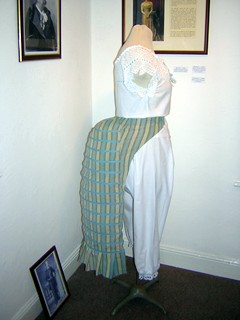 |
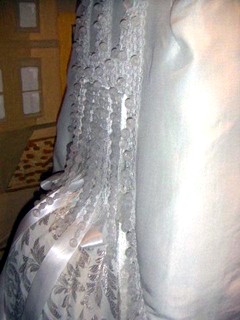 |
|
The bustle, which dates from circa 1885:
replica made by Claire Hart in striped ticking with wire hoops over
white cotton chemise with hand-crocheted lace |
Extremely complex and fine
detail was concentrated at the back to emphasize the design of the
bustle. Pinning the braid on to the jacket look a whole day |
"The romance of recreating an old costume
grabbed my imagination. My passion is to sew. I have been sewing since I
was seven years old. My mother had a treadle sewing machine and as soon as
my legs were long enough to reach the pedal I began to sew. If the house
caught fire I'd take the boys and my machine," added teaching assistant
and tailoress Lesley Wade.
"I had some white silk brocade which had
been the train from a 1930's wedding dress and felt that it should be used
for something really nice. Knowing about the Worth project I began to look
for pictures of his dresses and saw that the dress fabric for one of his
creations was like the material I was keeping. I rang Brenda and was
hooked. I have always loved beading and ribbon embroidery and my business
sometimes involves repairing and mending quite fragile clothes," said
ceramics and stained-glass artist Claire Hart who also buys and sells
vintage fashion.
|
"We have brought one of his dresses back to
life, which is a touch spooky," said Lesley who did the pattern
cutting. |
Together they have made a replica of an
off-white silk faille visite (originally made in about 1885 by Worth),
which was a type of coat considered fashionable in combination with the
bustle style. It has an opening to accommodate the projecting back of the
skirt, which has a long train. The extremely complex and finely detailed
decorations for such a design were concentrated at the back to emphasise
the design of the bustle. It has braid and bead trimming. Pinning the
braid onto the jacket took a whole day.
"My main contribution has been finding the materials for the trimmings and
beading so that the finished product looks as authentic as possible. I
knitted the collar and muff, which are made of fur on the original dress,
but we have used wool. There was quite a bit of detective work to get the
right colour match for the braid which seems to be used in upholstery
nowadays more than in dress making." said Debbie.
|
All
experienced seamstresses with a passion for the
history of fashion, the team were able to plan and make this
stunning dress just from a photograph |
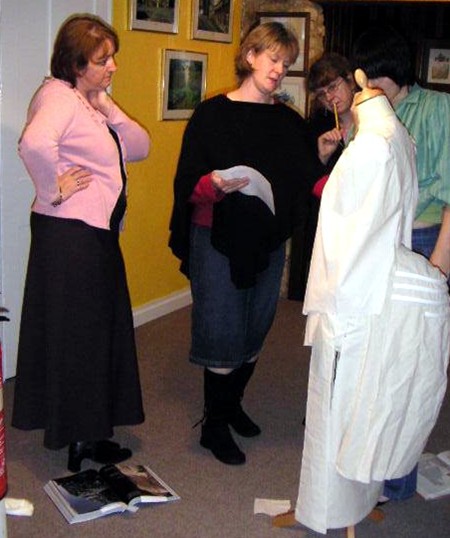 |
Each contributor has a number of qualifications in needlework and textiles
and has an interest in the history of fashion. Essentially they are highly
skilled and consequently, able to work from a photograph and not a working
drawing. They copied a creation, which Charles Worth would have designed
himself by putting pen to paper. "We have brought one of his dresses back
to life, which is a touch spooky," said Lesley who did the pattern
cutting.
"It is really hard to work out what the
shapes are when they are flat. I found a wonderful book called 'The Cut of
Women's Clothes from 1600s to 1900s' which has been my bible for this
project. I had five goes at cutting out the pattern; trying it on the
mannequin each time and then I made a toile in calico. It is really clever
the way he got the shape and cut and where the darts are. None of them are
in a standard place. The silk brocade skirt which is worn with the jacket
was made in the same way," said Lesley.
"Worth certainly was not a fan of less is more because the detail on his
dresses is beyond belief. It was about taking fashion ten stages further
than anyone else had done," said Claire who researched the project, made
the bustle and collected pieces of Victorian costume for the exhibition.
The team is planning to make another replica dress later this year using
velvet.
NOTE: This article has been reproduced from the
September 2006 issue of
the magazine Sewing World, photographs courtesy Jim Jones
Return to The Worth Gallery

Go to:
Main Index Villages
Index
|





